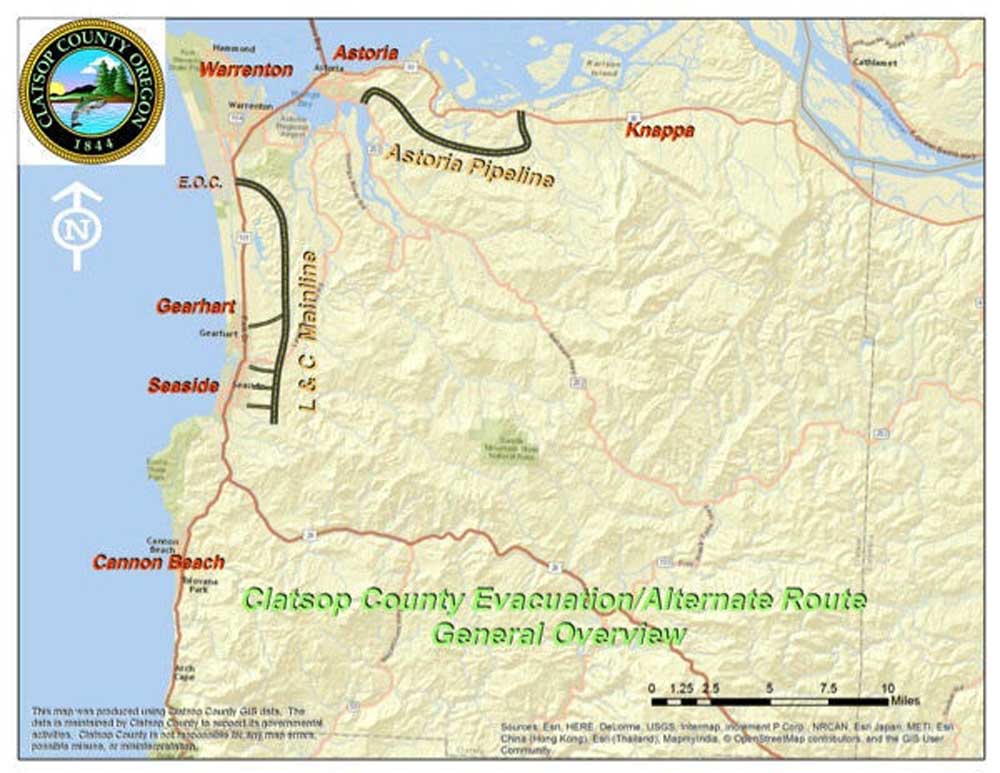A way out of town during disasters
Published 7:35 am Monday, August 8, 2016

- Clatsop County is exploring alternate and evacuation routes on the North Coast.
Seldom used back roads outside Astoria and Seaside could offer a lifeline in a Cascadia earthquake.
Clatsop County Public Works is exploring ways to create alternate and evacuation routes and have identified several possibilities, including some that are currently gated off on private timberland.
County staff are proposing upgrades to Pipeline Road that connects Astoria to the Svensen area, and the Lewis and Clark Mainline that runs outside Gearhart and Seaside.
Pipeline Road is an 11-mile county road, with only 2 miles that are maintained. Lewis and Clark Mainline is an old logging road that cuts along a ridge through the county.
The total cost to revamp all of the routes being looked at is more than $40 million and would add 40 miles to the county road system.
“It’s a long range type of a plan to go over a series of years, but it would really be an investment and provide some increased emergency and evacuation potential and better logistical support,” Public Works Director Michael Summers said.
Summers presented the idea to the Clatsop County Board of Commissioners last week. He knows cities in the county have their own transportation plans, but he hopes to work together with the various jurisdictions. The commissioners expressed their support, calling the proposal a good vision for the county.
“This is excellent, proactive thinking,” Commissioner Sarah Nebeker said. “It may not meet everybody’s needs, but I think it’s a great start.”
The county is planning a work session this fall to talk about different funding strategies and options. Besides seeking grants, Summers said, the county could get creative and fund the work through a local gas tax or bond measure. Each strategy has positives and negatives, he said.
Another option is to focus on one project at a time. As an example, making Pipeline Road a viable route would cost about $15 million.
The Public Works Department recently submitted a grant application to the state to study tsunami evacuation planning, which includes researching evacuation routes. If funded, the county would receive $90,000 to complete the work.
In the county’s budget, the road division set aside $50,000 to begin a feasibility study for the alternate routes. The funds could pay for a consultant to help with studies and actively pursue grant funding.
As the county considers the alternate and evacuation routes, Summers said, some of the routes could have insurmountable constraints such as private property, wetlands and historical site concerns.
“There is a fair amount of public outreach that has to happen,” he said.
Restoring Pipeline Road and Lewis and Clark Mainline would connect traffic to U.S. Highway 30 and U.S. Highway 101, while offering a way around the congestion on the highways.
The county’s proposal also includes restoring the Fletcher Mainline outside Gearhart and three evacuation routes in Seaside that would connect to the Lewis and Clark Mainline.
Bill Johnston, a state transportation planner, said the Oregon Department of Transportation and city of Astoria agreed two years ago that a bypass could not be done in the foreseeable future. Instead, the state and the city put support behind upgrading existing rural roads as an alternate route, rather than a bypass.
A bypass is not part of the county’s plans.
“We are not talking about a bypass,” Summers said. “We are talking about other ways around town.”
From the state’s perspective, Highway 202 already provides an alternate route around Astoria.
“If the purpose of establishing an alternative route is primarily to provide an escape route in the event of a natural disaster, it may be a more practical option to focus on upgrading OR 202 rather than constructing a new route,” Johnston wrote to the city of Astoria.
New alternative routes are not a simple matter, Johnston said, since there can be permitting issues and geological hazards that would make work difficult.
“It’s a complicated issue,” he said.
When considering the benefits of new alternate routes, some believe heavy semitruck traffic will be eliminated through downtown Astoria. However, Johnston points out that trucks will continue to travel through downtown to reach the Port of Astoria or the Astoria Bridge.
“Rural roads have too many sharp curves and steep grades,” Johnston wrote.
Emergency responders do see alternate routes as a major benefit.
Knappa Fire Chief Paul Olheiser said his coverage area contains about six bridges that have to be crossed to serve the community. If the bridges crumble in a natural disaster, the fire department will rely on alternate routes such as Pipeline Road.
“I’m in mind to believe those bridges are going to fail (in an earthquake),” Olheiser said.
Between the Knappa and Svensen fire stations, road construction is blocking portions of U.S. Highway 30. For construction or heavy traffic, Olheiser said, other options help emergency responders. Often times, emergency crews are able to get around such delays, but sometimes they cannot.
“If the county can figure out a way to alleviate that, that would be good for everybody,” Olheiser said.





